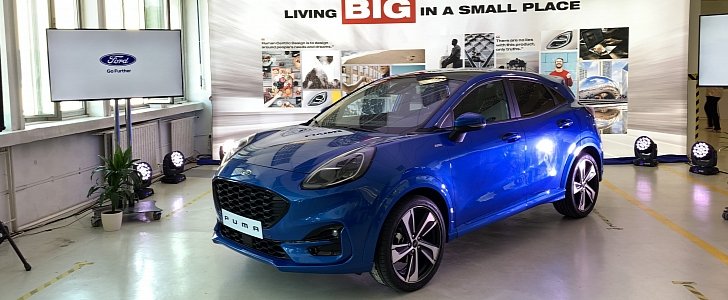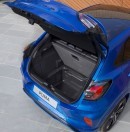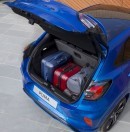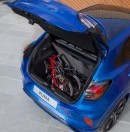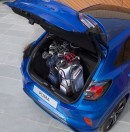Tiny houses are a big thing these days - every inch optimized, with people enjoying the coziness of a home without the burden of the classic recipe. So what would be the automotive equivalent of this? Well, I think it might be the 2020 Ford Puma.
This is the Blue Oval's idea of what a subcompact crossover should be like and Ford took me to the Craiova factory in Romania, where the model will be produced, for a static presentation of the Fiesta-based newcomer one day ahead of its official debut. You can check out a few live pics in the galley above, with these being found alongside the oficial images of the vehicle.
At least for now, the model is an Europe-only affair, with the said production site set to supply the entire continent.
Last time when Ford used the agile Fiesta platform for something called the Puma, it was the late 90s and we ended up with a happy-looking little coupe that was fun to drive.
This time around, the Blue Oval borrowed that nameplate for the crossover we have here, which means the fresh arrival has to deal with a lot of pressure - sure, those who are new to the story won't care, but enthusiasts aren't pleased when a badge goes though such a transformation.
So, can the little crossover make up for the polarizing nameplate inheritance? Well, if the thing drives as well as it looks, its sin might be forgiven.
Imagine someone threw firecrackers inside the Fiesta, with the car growing in every dimention: the Puma is 4,186 mm long (+146 mm), 1,805 mm wide (+71 mm) and sits 1,537 mm high (+54 mm). Note that the wheelbase has grown by 95 mm (to 2,588 mm) and the track width has been boosted by 58 mm, reaching 1,562 mm, while the overall tire diameter has jumped by 50 mm, getting up to 670 mm.
Sitting at 143 mm, the ground clearance is hardly the kind that invites one to veer off the road and enjoy some muddy hills. Nevertheless, you won't be scared of an unpaved road stint, or the occasional curb climbing - that torsion beam at the back is the one limiting the ride height. There's no underbody protection, at least not against rocks - plastic "shields" improve the aero to reduce fuel consumption.
If all those numbers got you tired, here's something that won't: the Puma competes against models such as the VW T-Roc, the Hyundai Kona, the Opel Mokka X, as well as the Renault Captur and the Nissan Juke, to name just a part of them.
"Doesn't the Puma share its class with the Ford Ecosport?" I hear you asking? Well, if the Ecosport is something you're likely to find in the hills, the new model enjoys trips to the coffee shop, so they're not exactly aimed at the same clientele.
Oh, and when you're chatting with your mates over that coffee, make sure to remind them that the optional all-LED headlights look like the eyes of the Ford GT. They might also resemble Porsche headlights, but I don't see how that would upset owners.
Fortunately, Ford hasn't built one of those SUV-coupes, so we don't have to talk about the ridicule of that genre. Instead, we're dealing with a machine that saw designers using an unconventional styling approach, one that seems to work rather well.
Oh, and you should know the new Ford Puma looks even better in the metal than it does in the photos. And while it's no secret that the appearance of the average new car has become angrier over the years, the Puma looks sharp, but still maintains that friendly attitude of the original.
Luckily, the luggage compartment is the result of an intelligent back-to-the-drawing board session. The Puma can swallow up to 456 liters of your stuff, which puts it at the top of its class.
The floor can be placed in multiple positions, but the really interesting trick lies underneath it. This is a space carmakers usually treat in a single manner, but Ford has decided to let us play with it.
Covered in plastic/rubber and packing a drain hole at the bottom, so it can store your dirty boots, this 80-liter compartment is brilliant - hey, my grandpa's 1960s Renault Dauphine also had drain holes in the back seat floor and I'm glad fashion is repeating itself.
Of course, if you'll go for a tire repair kit, a spare wheel or the battery for the one of the car's two mild-hybrid powertrains (more on this below), this space will get smaller. In fact, you can check out the full-size MegaBox in the video below.
You can have this model with a power-operated boot, the kind that also knows waht to do when you stick your foot underneath the rear bumper.
There are three trim levels, two of which I met on the Craiova floor: the Trend, the Titanium and the ST Line (you can try to guess which one was absent). The base spec comes with an analog instrument cluster, but you can have a digital one that's configurable - the graphics are nice.
Remember when your toddler (or your friend who acts like Joey from Friends) spilled that... something on your seats? Well, the Puma comes with zipper-attached covers that you can throw inside your washing machine or change as you please.
However, even though I've only spent a few minutes in the seats, it felt like they could be larger.
The three-cylinder gas mill can be had in 95 or 125 hp form, with the latter even packing a cylinder deactivation that allow it to run in two-cylinder mode. So while you're chasing lower emissions, you'll be like a motorcycle...
You can also go for 48V mild-hybrid assistance, with this delivering either 125 or 155 hp - the belt-driven starter-generator can add up to 11.5 kW (15.6 hp) and 20 Nm, while the system regenerates energy lost during braking and can see the engine being shut down even when you're doing 15 km/h.
A six-speed manual is standard, but a seven-speed dual-clutch is coming to the 125 hp engine (non-hybrid) starting from May next year.
Thanks to a FordPass Connect on-board modem, you can benefit from the Local Hazard Information notifications, which come from local authorities, emergency services, and other vehicles connected to this cloud.
Regardless, you'll find the full list of features in the press release below.
Speaking of which, the Puma hasn't been tested by Euro NCAP yet, with the carmaker aiming for a five-star rating.
I drove the Fiesta Active last year and wasn't impressed (all those accessories won't help you climb the smallest obstacle, so that trim is purely visual). Fortunately, the Ford Puma looks like the kind of jacked-up Fiesta that actually serves a functional purpose and I salute that.
The recipe isn't perfect, though. When asked about goodies such as AWD or an actual ST model, I was given the standard "no current plans" answer. Hopefully, we will at least get a on-stilts version of the brilliant Fiesta ST.
However, the the easy-on-the-eyes look of the new Ford Puma and its all-important practical side mean it has serious chances of making the small crossover segment a better place.
At least for now, the model is an Europe-only affair, with the said production site set to supply the entire continent.
Last time when Ford used the agile Fiesta platform for something called the Puma, it was the late 90s and we ended up with a happy-looking little coupe that was fun to drive.
This time around, the Blue Oval borrowed that nameplate for the crossover we have here, which means the fresh arrival has to deal with a lot of pressure - sure, those who are new to the story won't care, but enthusiasts aren't pleased when a badge goes though such a transformation.
So, can the little crossover make up for the polarizing nameplate inheritance? Well, if the thing drives as well as it looks, its sin might be forgiven.
Imagine someone threw firecrackers inside the Fiesta, with the car growing in every dimention: the Puma is 4,186 mm long (+146 mm), 1,805 mm wide (+71 mm) and sits 1,537 mm high (+54 mm). Note that the wheelbase has grown by 95 mm (to 2,588 mm) and the track width has been boosted by 58 mm, reaching 1,562 mm, while the overall tire diameter has jumped by 50 mm, getting up to 670 mm.
Sitting at 143 mm, the ground clearance is hardly the kind that invites one to veer off the road and enjoy some muddy hills. Nevertheless, you won't be scared of an unpaved road stint, or the occasional curb climbing - that torsion beam at the back is the one limiting the ride height. There's no underbody protection, at least not against rocks - plastic "shields" improve the aero to reduce fuel consumption.
If all those numbers got you tired, here's something that won't: the Puma competes against models such as the VW T-Roc, the Hyundai Kona, the Opel Mokka X, as well as the Renault Captur and the Nissan Juke, to name just a part of them.
"Doesn't the Puma share its class with the Ford Ecosport?" I hear you asking? Well, if the Ecosport is something you're likely to find in the hills, the new model enjoys trips to the coffee shop, so they're not exactly aimed at the same clientele.
Oh, and when you're chatting with your mates over that coffee, make sure to remind them that the optional all-LED headlights look like the eyes of the Ford GT. They might also resemble Porsche headlights, but I don't see how that would upset owners.
Fortunately, Ford hasn't built one of those SUV-coupes, so we don't have to talk about the ridicule of that genre. Instead, we're dealing with a machine that saw designers using an unconventional styling approach, one that seems to work rather well.
Oh, and you should know the new Ford Puma looks even better in the metal than it does in the photos. And while it's no secret that the appearance of the average new car has become angrier over the years, the Puma looks sharp, but still maintains that friendly attitude of the original.
Interior
As for the cabin, it's no surprise this is slightly roomier than that of the Fiesta. Nevertheless, the height of the door aperture is limited, as is the headroom in the back (only those up to 1.75m can fit perfectly).Luckily, the luggage compartment is the result of an intelligent back-to-the-drawing board session. The Puma can swallow up to 456 liters of your stuff, which puts it at the top of its class.
The floor can be placed in multiple positions, but the really interesting trick lies underneath it. This is a space carmakers usually treat in a single manner, but Ford has decided to let us play with it.
Covered in plastic/rubber and packing a drain hole at the bottom, so it can store your dirty boots, this 80-liter compartment is brilliant - hey, my grandpa's 1960s Renault Dauphine also had drain holes in the back seat floor and I'm glad fashion is repeating itself.
Of course, if you'll go for a tire repair kit, a spare wheel or the battery for the one of the car's two mild-hybrid powertrains (more on this below), this space will get smaller. In fact, you can check out the full-size MegaBox in the video below.
You can have this model with a power-operated boot, the kind that also knows waht to do when you stick your foot underneath the rear bumper.
There are three trim levels, two of which I met on the Craiova floor: the Trend, the Titanium and the ST Line (you can try to guess which one was absent). The base spec comes with an analog instrument cluster, but you can have a digital one that's configurable - the graphics are nice.
Remember when your toddler (or your friend who acts like Joey from Friends) spilled that... something on your seats? Well, the Puma comes with zipper-attached covers that you can throw inside your washing machine or change as you please.
However, even though I've only spent a few minutes in the seats, it felt like they could be larger.
Power
The engine compartment can be occupied by either a 1.0-liter EcoBoost tree-cylinder or a 1.5 TDCI diesel four-pot with 120 hp.The three-cylinder gas mill can be had in 95 or 125 hp form, with the latter even packing a cylinder deactivation that allow it to run in two-cylinder mode. So while you're chasing lower emissions, you'll be like a motorcycle...
You can also go for 48V mild-hybrid assistance, with this delivering either 125 or 155 hp - the belt-driven starter-generator can add up to 11.5 kW (15.6 hp) and 20 Nm, while the system regenerates energy lost during braking and can see the engine being shut down even when you're doing 15 km/h.
A six-speed manual is standard, but a seven-speed dual-clutch is coming to the 125 hp engine (non-hybrid) starting from May next year.
Safety
Based on three radars (front and side-facing at the back) and two cameras (front and back), the Ford Puma can be had with an array of active safety features, such as Adaptive Cruise Control with Stop & Go and Blind Spot Information System (BLIS) with Cross Traffic AlertThanks to a FordPass Connect on-board modem, you can benefit from the Local Hazard Information notifications, which come from local authorities, emergency services, and other vehicles connected to this cloud.
Regardless, you'll find the full list of features in the press release below.
Speaking of which, the Puma hasn't been tested by Euro NCAP yet, with the carmaker aiming for a five-star rating.
The bottom line (at this point)
Puma production kicks off this fall, on the same line as the EcoSport, following an €200 million investment. Sales are scheduled to begin in Q4 2019. There's no official pricing yet, but the new model should come with a starting price of around €16,000 (VAT included), with plenty of options to take things past the €20,000 point.I drove the Fiesta Active last year and wasn't impressed (all those accessories won't help you climb the smallest obstacle, so that trim is purely visual). Fortunately, the Ford Puma looks like the kind of jacked-up Fiesta that actually serves a functional purpose and I salute that.
The recipe isn't perfect, though. When asked about goodies such as AWD or an actual ST model, I was given the standard "no current plans" answer. Hopefully, we will at least get a on-stilts version of the brilliant Fiesta ST.
However, the the easy-on-the-eyes look of the new Ford Puma and its all-important practical side mean it has serious chances of making the small crossover segment a better place.
